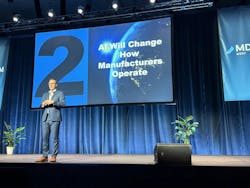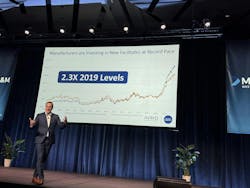The Shift from Digitization to Datafication in Manufacturing
On Wednesday morning, Shawn DuBravac, Ph.D., CFA, delivered a keynote at MD&M West that addressed shifts in the manufacturing sector. He highlighted the transition from digitization—a focus that he noted has dominated the last two decades—to datafication, which he predicts will shape the coming decades.
From Ice Harvesting to Data-Driven Manufacturing
DuBravac took the audience on a historical journey, back to the late 1800s, when ice harvesting was a significant industry in colder states like Michigan and New York. At its peak, this industry involved more than 100,000 workers and 25,000 horses. Ice was harvested from frozen rivers and lakes, and it played a critical role in food preservation. However, technological advancements soon shifted the industry toward ice manufacturing in urban centers, revolutionizing how ice was produced and consumed.
He illustrated that each technological shift often leaves behind established players, much like how the ice harvesting industry transformed. The traditional ice harvesters could not adapt to the newly manufactured ice market dominated by companies like GE and Frigidaire.
Investment and Transformation in Manufacturing
Moving to contemporary times, DuBravac pointed out that U.S. manufacturers are currently investing in new facilities at an unprecedented pace—200% more than prior to the pandemic. This investment reflects a shift towards highly digitized, efficient manufacturing systems. While electronics, particularly semiconductors and the electric vehicle (EV) ecosystem, are leading this transformation, he noted that the food and beverage industry also witnesses similar investment growth.
READ MORE: Lean into the Blur of Chaotic Change
He urged industry leaders to navigate these changes by considering both immediate operational needs and future market demands. The future of manufacturing requires balancing current customer satisfaction with forward-thinking strategies to meet emergent needs 5-10 years down the line.
The Role of AI, Datafication
DuBravac talked about the role of artificial intelligence (AI) and the transition to datafication, focusing particularly on how AI can improve operational efficiencies. He cited examples such as JetBlue’s integration of generative AI into its customer service operations, which significantly reduced call handling times.
He also discussed the concept of AI-driven knowledge management in companies like Georgia Pacific, where generative AI systems integrated operational knowledge, helping with training and operational efficiency.
In discussing the workforce’s evolution alongside AI, DuBravac mentioned younger generations' comfort with technology, suggesting that workers are already adapting to automated systems. Addressing concerns about job displacement, he said that AI would likely not replace jobs outright but rather change the nature of work, stressing the importance of upskilling and preparing the workforce for future roles.
He also referred to innovative applications in various industries, like John Deere’s AI-equipped tractors that have changed farming practices by using fewer inputs while still achieving desired outcomes.
READ MORE: Elevating Expertise with MD&M West’s Educational Opportunities
DuBravac wrapped up his keynote by stressing that businesses must be open to experimenting with AI technologies, understanding that its integration would reshape business models and relationships with customers. He highlighted the significant shifts occurring in manufacturing, driven by technological advancements and the necessity for industries to rethink their operations amidst an ever-evolving landscape.
The takeaway is clear: the combined strength of human intelligence and machine capabilities will define the future of manufacturing.
Editor’s note: For more show coverage, be sure to check out our MD&M West 2025 content hub.
About the Author
Sharon Spielman
Technical Editor, Machine Design
As Machine Design’s technical editor, Sharon Spielman produces content for the brand’s focus audience—design and multidisciplinary engineers. Her beat includes 3D printing/CAD; mechanical and motion systems, with an emphasis on pneumatics and linear motion; automation; robotics; and CNC machining.
Spielman has more than three decades of experience as a writer and editor for a range of B2B brands, including those that cover machine design; electrical design and manufacturing; interconnection technology; food and beverage manufacturing; process heating and cooling; finishing; and package converting.
Email: [email protected]
LinkedIn: @sharonspielman
Facebook: Machine Design
YouTube: @MachineDesign-EBM


